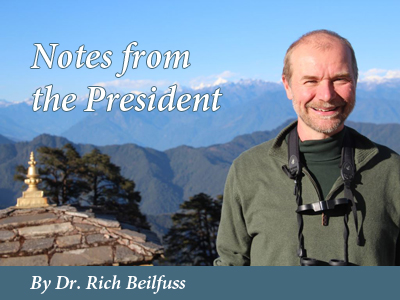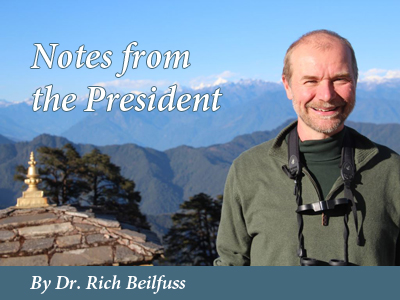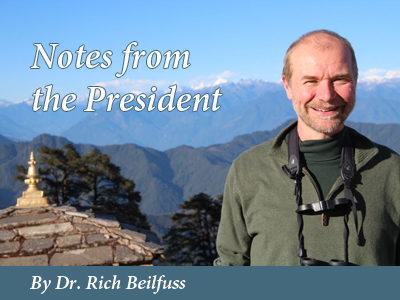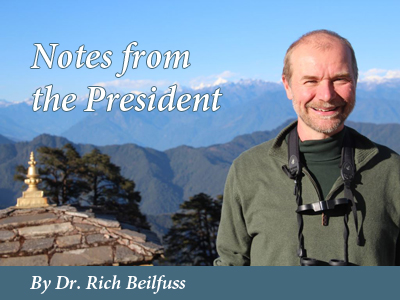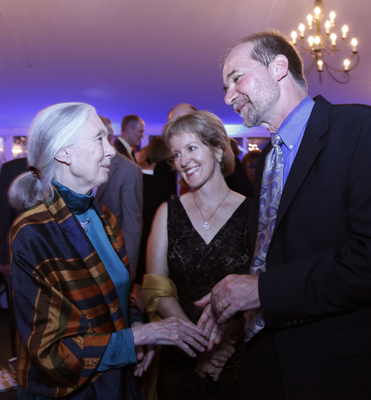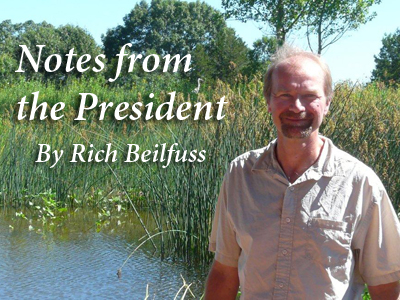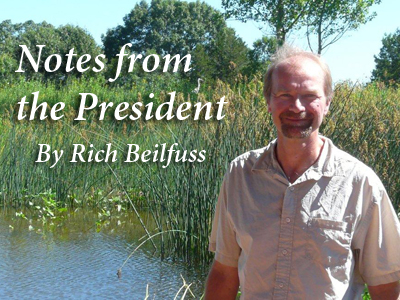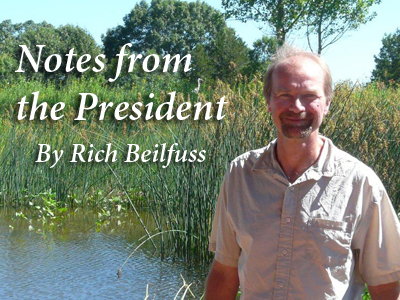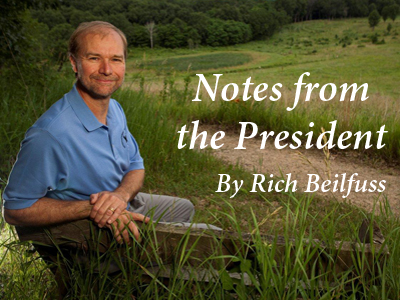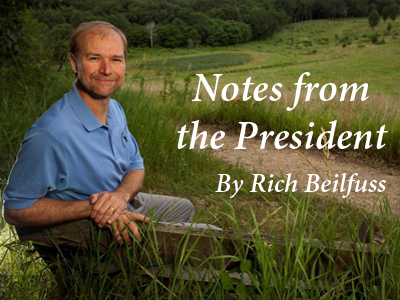
It has been a time of reflection and celebration in the world of cranes and craniacs. We commemorated the 100-year passing of the last passenger pigeon, once the most abundant bird in North America, with a strong reminder that extinction is forever and the conservation stakes have never been higher.
Tag: Notes from the President
Notes from the President
 In June we basked in another glorious Evening with the Cranes – how delightful to stroll our site with friends and supporters, and feast in local flavors, regional wines, and prairies in peak bloom. As with our big Anniversary Gala last year in Milwaukee, we are learning how to throw a good party in honor of all of you who make our work possible.
In June we basked in another glorious Evening with the Cranes – how delightful to stroll our site with friends and supporters, and feast in local flavors, regional wines, and prairies in peak bloom. As with our big Anniversary Gala last year in Milwaukee, we are learning how to throw a good party in honor of all of you who make our work possible.
Notes from the President
 I would have failed photography school. Whenever I find myself in the exotic crane places of the world, I am flanked by photographers who are able to capture the elegance and excitement – the pure charisma – of cranes in the most breathtaking ways. My camera, however, tends to focus less on the dramatic beauty and more on the menacing threats to the crane world. A Blue Crane roosting under a big, ugly powerline – click! A Wattled Crane struggling to feed on a parched, dusty floodplain – snap!
I would have failed photography school. Whenever I find myself in the exotic crane places of the world, I am flanked by photographers who are able to capture the elegance and excitement – the pure charisma – of cranes in the most breathtaking ways. My camera, however, tends to focus less on the dramatic beauty and more on the menacing threats to the crane world. A Blue Crane roosting under a big, ugly powerline – click! A Wattled Crane struggling to feed on a parched, dusty floodplain – snap!
Notes from the President
 Midway along our journey from New Delhi to Bharatpur, we pulled our bus off the highway and leapt out to scan for birds and other things that might flash in our binoculars and cameras. At first glance, these intensively farmed lands, flush with people everywhere, didn’t seem a good prospect for wildlife viewing. But as the small wetlands dotting this landscape came deeper into focus, species after species appeared — a wealth of ducks, cormorants, ibises, spoonbills, storks, herons, kingfishers, and shorebirds.
Midway along our journey from New Delhi to Bharatpur, we pulled our bus off the highway and leapt out to scan for birds and other things that might flash in our binoculars and cameras. At first glance, these intensively farmed lands, flush with people everywhere, didn’t seem a good prospect for wildlife viewing. But as the small wetlands dotting this landscape came deeper into focus, species after species appeared — a wealth of ducks, cormorants, ibises, spoonbills, storks, herons, kingfishers, and shorebirds.
Notes from the President
 Wow, what a time we had! From Heather Henson’s thrilling Celebration of Flight, to Dr. Jane Goodall’s inspiring words for the conservation leaders of tomorrow, our 40th Anniversary Gala stirred the heart. Whether you joined us in Milwaukee, or in spirit, each of you — our sponsors, members, supporters, and partners — made possible the wonderful achievements we honored.
Wow, what a time we had! From Heather Henson’s thrilling Celebration of Flight, to Dr. Jane Goodall’s inspiring words for the conservation leaders of tomorrow, our 40th Anniversary Gala stirred the heart. Whether you joined us in Milwaukee, or in spirit, each of you — our sponsors, members, supporters, and partners — made possible the wonderful achievements we honored.
Notes from the President
 Forty Years! The advent of our 40th anniversary is an important time to reflect on our many achievements, to assess the conservation challenges that lay ahead, and to chart a clear course for the future.
Forty Years! The advent of our 40th anniversary is an important time to reflect on our many achievements, to assess the conservation challenges that lay ahead, and to chart a clear course for the future.
Notes from the President
 When I think about the conservation challenges we face in the coming century, my thoughts invariably turn to food, water, and energy. How will we feed 9 billion people and still maintain healthy landscapes for cranes and other life we hold dear? How will we water thirsty cities and farmlands without sacrificing life-supporting rivers and wetlands? Can we meet the global demand for electricity without devastating our land, water, air…and climate?
When I think about the conservation challenges we face in the coming century, my thoughts invariably turn to food, water, and energy. How will we feed 9 billion people and still maintain healthy landscapes for cranes and other life we hold dear? How will we water thirsty cities and farmlands without sacrificing life-supporting rivers and wetlands? Can we meet the global demand for electricity without devastating our land, water, air…and climate?
Notes from the President
 In mid-June we enjoyed another magical night at the International Crane Foundation. An Evening with the Cranes drew friends from across the country to share wine, food, and song from the crane regions of the world, under a beautiful summer sky.
In mid-June we enjoyed another magical night at the International Crane Foundation. An Evening with the Cranes drew friends from across the country to share wine, food, and song from the crane regions of the world, under a beautiful summer sky.
Notes from the President
 This past February, Wisconsin legislators introduced an assembly bill that would authorize the hunting of Sandhill Cranes in Wisconsin. The bill was defended as a necessary measure to reduce crop depredation caused by Sandhill Cranes, and to enable farmers to apply for wildlife damage abatement assistance and claim payments.
This past February, Wisconsin legislators introduced an assembly bill that would authorize the hunting of Sandhill Cranes in Wisconsin. The bill was defended as a necessary measure to reduce crop depredation caused by Sandhill Cranes, and to enable farmers to apply for wildlife damage abatement assistance and claim payments.
Notes from the President
 Conservation leadership is at the heart of ICF’s global mission to save cranes and the diverse ecosystems, watersheds, and flyways on which they and all of us depend. We are dedicated to inspiring and empowering leaders at all levels. We provide training and practical experience for individuals and organizations engaged in community-based conservation, education, and outreach at key crane sites, building on their knowledge of cultural norms and practices. We also facilitate international leadership on key cross-cutting issues that affect cranes, such as sustainable water management. And sometimes conservation leaders find us, and together we tackle challenges beyond the reach of ICF alone. In this issue, we share stories from conservation leaders who are on the front lines of saving cranes and their landscapes on three continents.
Conservation leadership is at the heart of ICF’s global mission to save cranes and the diverse ecosystems, watersheds, and flyways on which they and all of us depend. We are dedicated to inspiring and empowering leaders at all levels. We provide training and practical experience for individuals and organizations engaged in community-based conservation, education, and outreach at key crane sites, building on their knowledge of cultural norms and practices. We also facilitate international leadership on key cross-cutting issues that affect cranes, such as sustainable water management. And sometimes conservation leaders find us, and together we tackle challenges beyond the reach of ICF alone. In this issue, we share stories from conservation leaders who are on the front lines of saving cranes and their landscapes on three continents.

